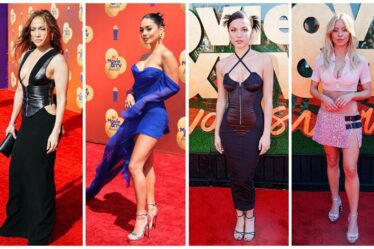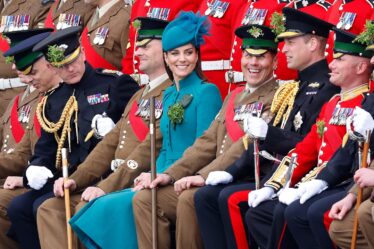Ariana Grande has released three platinum singles this year, hosted “Saturday Night Live” and been gearing up for the November premiere of the film adaptation of the musical “Wicked”, in which she plays a starring role alongside Cynthia Erivo.
For Swarovski, which has made “joyful extravagance” and “pop luxury” hallmarks of its post-pandemic turnaround strategy, a campaign featuring the ebullient star lensed by photography duo Mert and Marcus couldn’t have been better timed.
The campaign — which depicts Grande laughing and partying in a festive club scene, iced out in stacked Swarovski bracelets, necklaces, earrings and a headband — comes as Swarovski seeks to keep beating a global slowdown in luxury shopping. Sales rose 4.5 percent in the first half of the year, chief executive Alexis Nasard says. Meanwhile, many luxury firms have seen sales fall (in some cases by double digits), reversing the previous trend of top-priced names outperforming the market.
In recent years, Swarovski has sought to return itself to profitability by blending traditional codes of luxury like heritage, creativity and artistry with “pop” qualities like a comprehensive range of price points, ubiquitous distribution and efforts to stay plugged into contemporary culture, Nasard says, all of which are echoed in its tie-up with Grande. The campaign is likely to be followed up by other activations as part of a one-year ambassadorship signed with the singer.
“There’s access and endorsement to a very large population that we consider strategic for our business. Then there’s the values that she can associate us with,” Nasard says, describing her as “a complete artist” known for her “accessibility, warmth and friendliness.”
Swarovski, a crystal maker founded in Austria in 1895, named its first-ever creative director — Giovanna Engelbert — in 2020 and its first CEO from outside its founding family in 2022 as it sought to bounce back from a pandemic slump.
The group (which also owns subsidiaries selling lenses for optical and industrial uses) set about relaunching the Swarovski Crystal business by ramping up production of larger and more colourful statement pieces. Engelbert’s hero items include the irregular Gemma necklace ($500) and the chunky Millenia ($650), more expensive than the small white-crystal pendants that used to drive sales, but thousands cheaper than the Georgian-era strands of semi-precious stones like amethyst, topaz and citrine that are famously featured in Vogue editor Anna Wintour’s daily uniform.

As part of its turnaround plan, the brand has reset its marketing message through collaborations with top fashion names. Steven Miesel shot campaign images with elaborate crystal makeup by Pat McGrath, while Mert and Marcus lensed a previous campaign with model Bella Hadid. McGrath collaborated with Swarovski on viral looks for Doja Cat (front row at Schiaparelli) and Lil Nas X (at the 2023 Met Gala). For this year’s Met Gala, Swarovski dressed Karlie Kloss, Irina Shayk, Imaan Hammam, and Anok Yai in crystal couture gowns designed by Engelbert.
Reasserting the brand’s fashion credibility was an important step, because “Swarovski is a very design-driven purchase, and less of a material-driven purchase,” Nasard says.
Feedback from the market has been “encouraging.” Revenues in Swarovski’s crystal business rose 4 percent last year to €1.8 billion. Operating profit returned to positive territory excluding restructuring costs.
Looking ahead, Nasard hopes to keep outperforming the wider jewellery market by ramping up marketing in the US — “where people are less stiff in their definitions of luxury; they are much more receptive to new messages, new positionings, new cultural phenomena,” he says — and where the company’s nascent lab-grown diamond division has quickly gained traction.
Lab-grown diamonds offer new opportunities to supply gifting and special occasions, as well as providing mutual “halo effects” alongside the brand’s crystal jewellery, Nasard says. The exuberant designs of Swarovski’s crystal jewellery help create a more exciting, creative context for lab-grown diamond items; while the presence of diamonds enhances the perception of Swarovski’s legitimacy to sell higher-end items.
Still, the brand is wary of telegraphing “Luxury” with a capital-L too strongly, particularly as the category cools down. Desirability at Swarovski is measured not just by whether customers perceive the brand as relevant, but by whether it seems relevant to them, Nasard says.

Collaborations with figures from high fashion have been balanced by “social culture” — working with Kim Kardashian and her intimates brand Skims last year — pop music and cinema (Grande) or art and design (staging an exhibition in Milan’s newly renovated Palazzo Citterio museum).
“Once we established the fashion [message], the question was how can we evolve the codes we created,” Engelbert explains. “What’s important for me is to keep the creative energy high, to keep it consistent but also timely and relevant. And for people to know everyone’s invited. It’s a fantasy land where you can actually buy things.”
Nasard is bullish on the future: “One of the ways to look at the potency of a strategy is that it gives you headroom, do you have headroom for growth or are you capped by your strategic choices?”
“On the product side there still is a lot we can do,” he says. “Just imagine us transposing our design language to other [categories]. Think about watches, think about accessories. There are lots of areas where we can still expand our new creative and design vision.”


